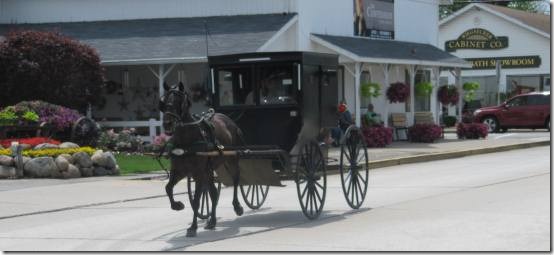Shipshewana, Indiana: I wonder about the Amish here in this dollhouse town. Things must splinter from time to time. Man-with-long-beard-in-buckboard must roll his eyes everyday, just to keep himself collected and sane. Either that, or he has come to terms with the taint of relieving cash from tourists by selling them cultural novelties. And keeping the shop closed on Sunday has retained for him some semblance of dignity and given the tourists a sense of the seriousness of hocking Amish popcorn.
I put my camera away but not before taking the all encompassing photo that has captured the well of Amish essence. Look: You can tell by the way his horse trots on this paved main street that his woman has hung out the day’s laundry and manicured the flower bed that’s full of pansies. See how she has re-pinned her bonnet in the breeze and now makes her flowing way to the henhouse calling over her shoulder to her cottoned daughter to put the fresh bread on the sill to cool. You can see in the bearded profile the calculations of bushels more of corn from the 40-acre square that was seeded right to edge this year; and in his eyes you sight the reflection of harness, the hames and the traces and the security of the fetlock and gaskin, of years spent behind horses, and the reverence for a transplanted ethos brought from across the sea. From the Anabaptists to Menno Simons (Mennonites) to Jakob Ammann, you see in his hardened hands, all these runs at simplicity of life and separation from the crud of the world. And you feel drawn towards it all like a great find in an antique shop, like say, a 200-year-old cherry wood desk.
Beside me the heavy lady holding the double-scoop vanilla cone, bemused by such differences, collects her impression for Wednesday evening canasta. Me? of course I’m above all that. Above the mealy piety of plodding tourist.
It’s curious how I think that my minute of proximity to people who actually still have the memory for the lay and tilth of land, who have that land under their fingernails, convinces me I understand their passions and longings and their reasons for allowing me a look at their way of life.
And I almost nod when I overhear the comment that the Amish were the original environmentalists. Of course the Amish were never out to save the environment. But their way of simplicity, industry, devotion to something beyond themselves, beyond the earth, precluded the need for environmental concern. It’s a huge romantic spin to say that if we all lived like the Amish there would not be a human engendered environmental crisis; except that it’s true. But that would also mean I wouldn’t be writing you this on my netbook.
Do I collect this postcard? Or will my visit stir in me a shuffle-step toward less-is-more?


Very thoughtful post, Stephen – thank you.
They are motivated of course by a particular understanding of Genesis 1:28ff – “Be fruitful and increase in number; fill the earth and subdue it. Rule over the fish of the sea and the birds of the air and over every living creature that moves on the ground.”
Thanks Trileigh!
True Sam, but their way of “filling, subduing, ruling,” leaves a much smaller footprint.
I’m wondering if that way of life would be sustainable if there were 6 billion of them.
Now there’s a picture. 6 Billion Amish: great shortages of candle wax and gingham, and endless debates about the staggering amount of horse manure…
Great insight, Stephen. Have you watched Devil’s Playground? I often wish that tradition carried over to everyone – that adolescents were allowed to permanently leave the family and community if they so choose, never to return or if they stay, they are obligated to become part of the community in the truest sense.
6 billion amish could raise a lot of barns.. Or, one reeeeally big one..
Thanks Lisa. No I haven’t watched the film you mention. But now I’m curious.
Mike, I’m picturing a very long dinner table at that colossal barn raising.
ok where does one sign up to become Amish?